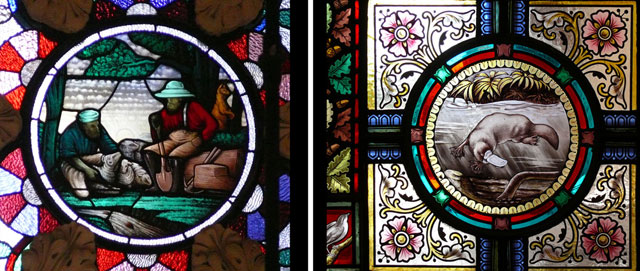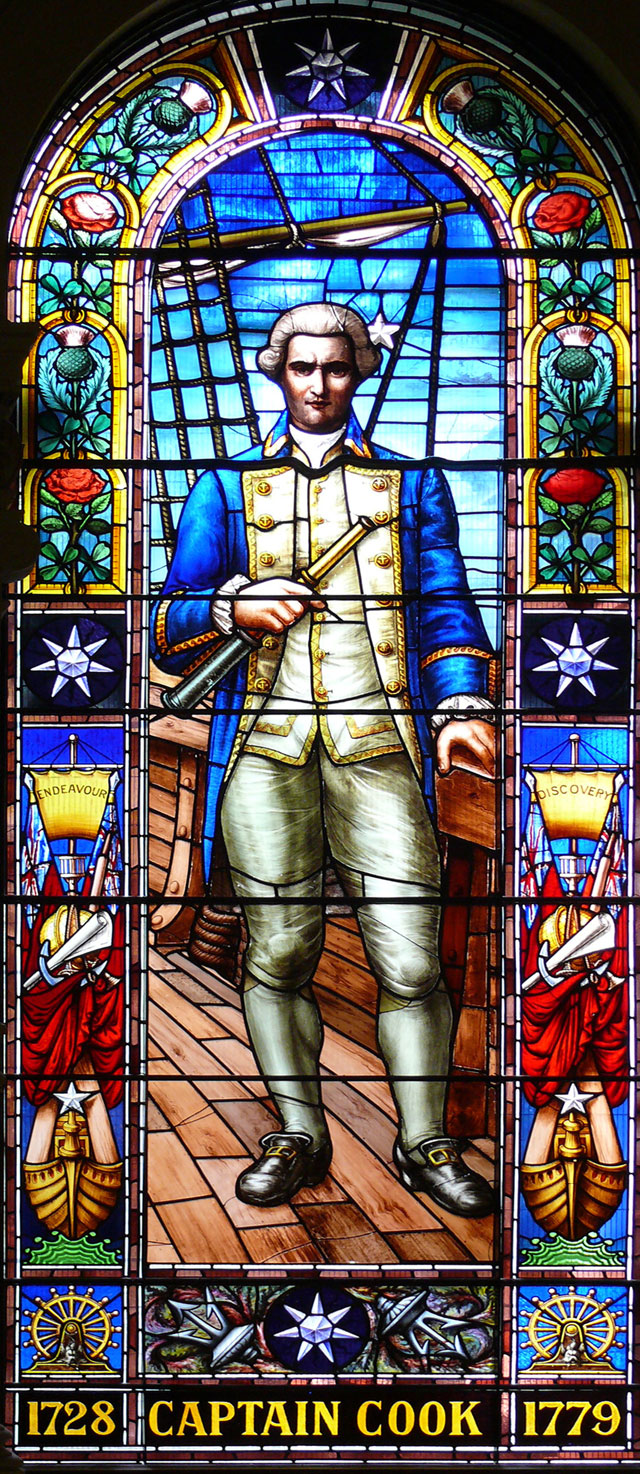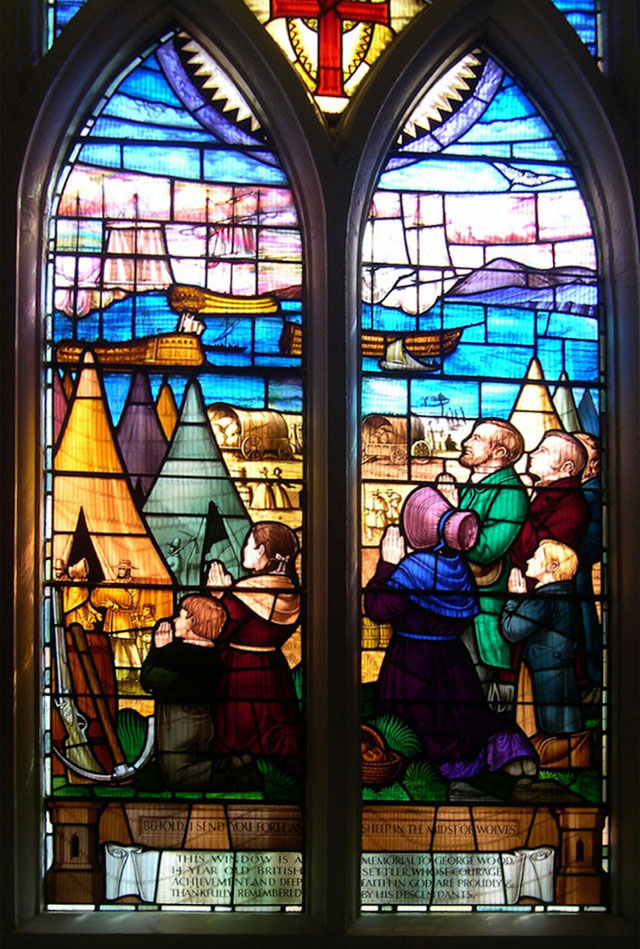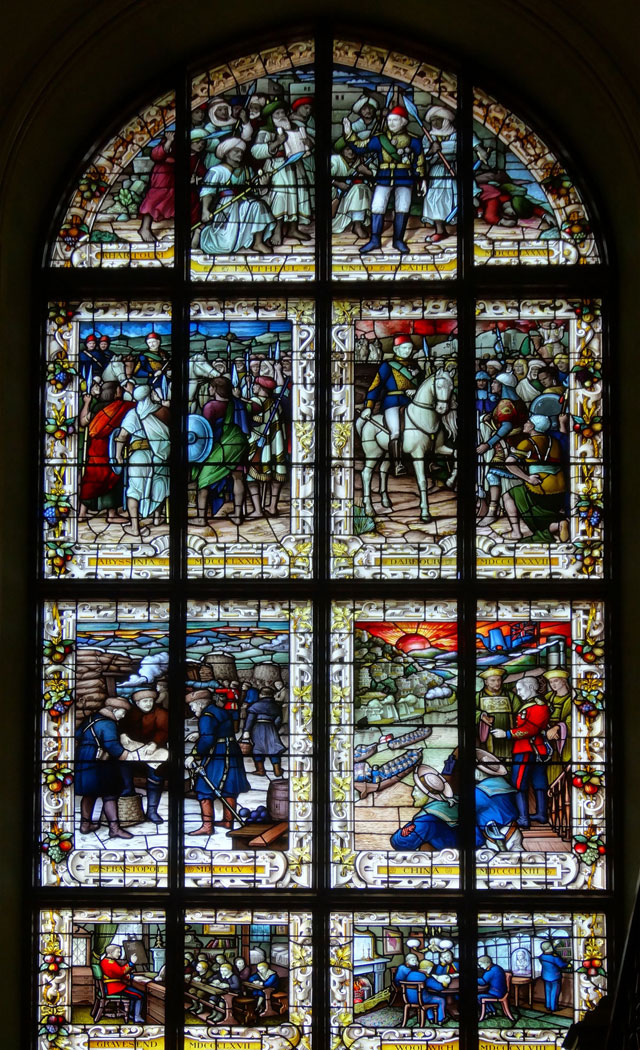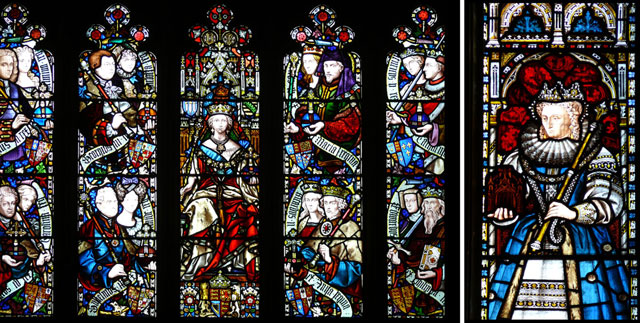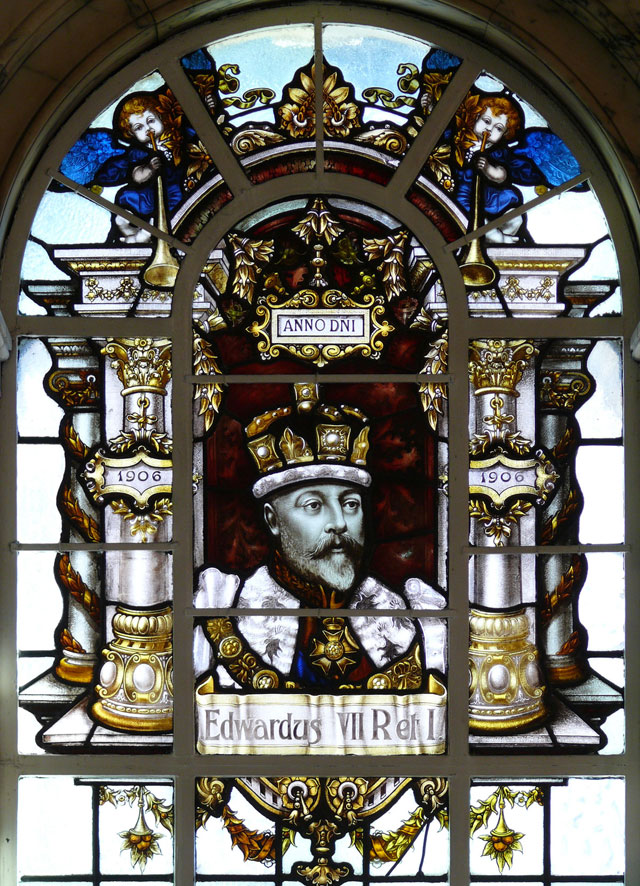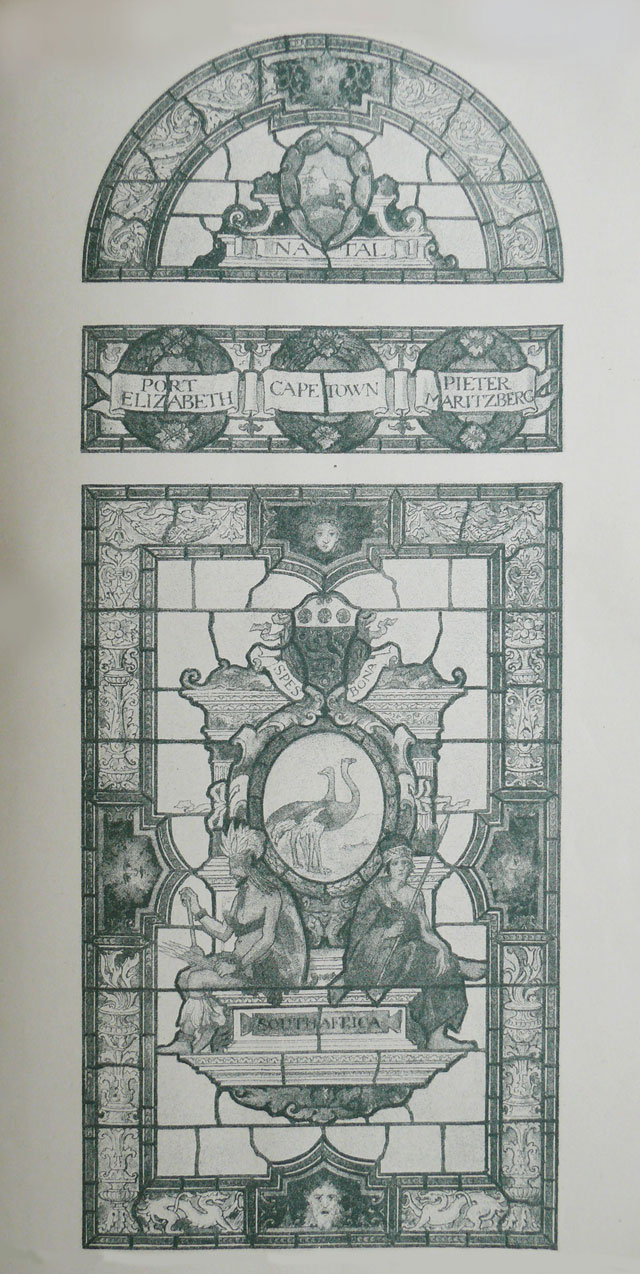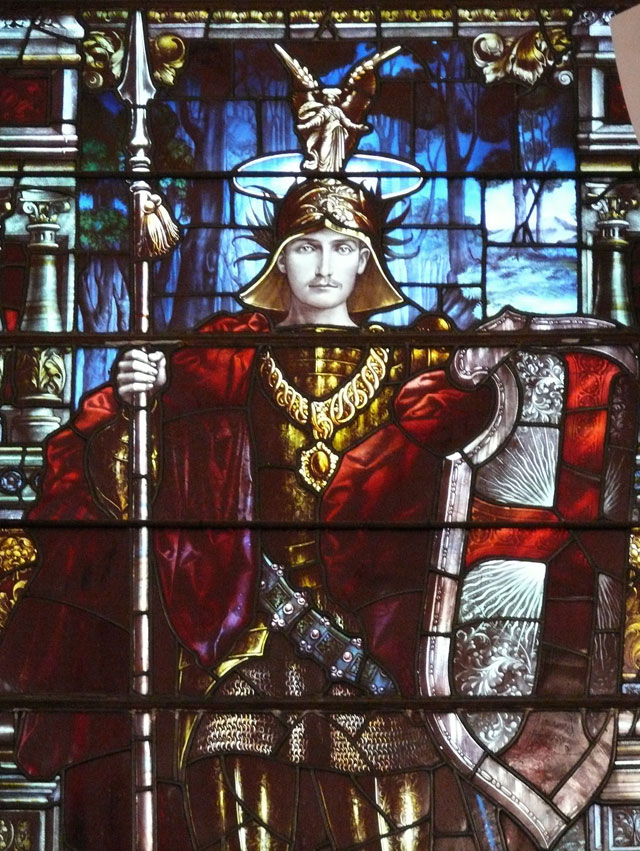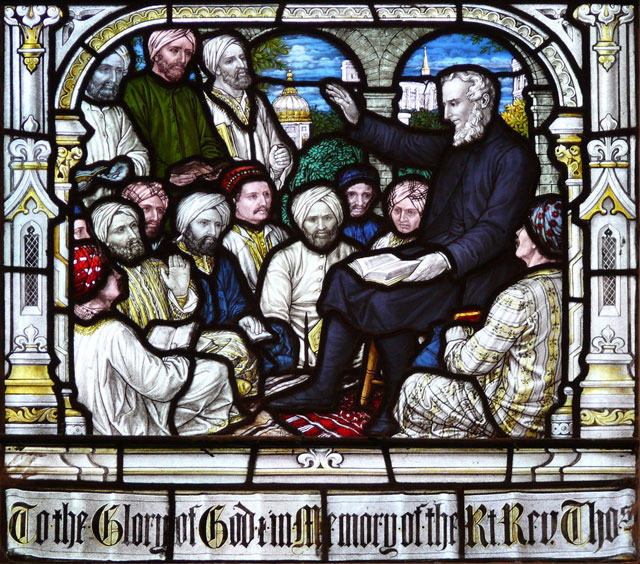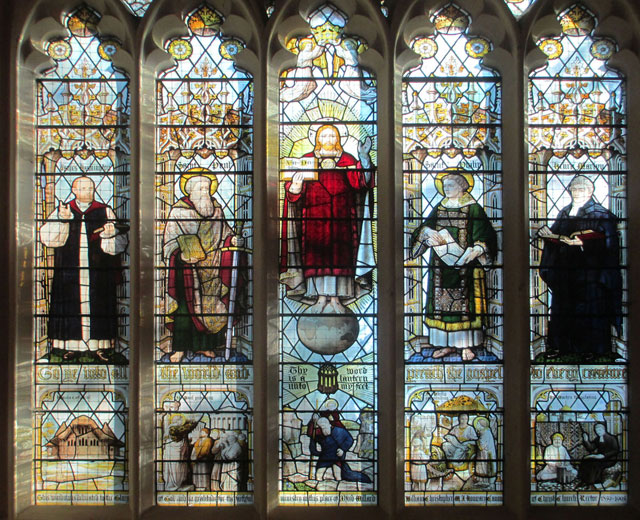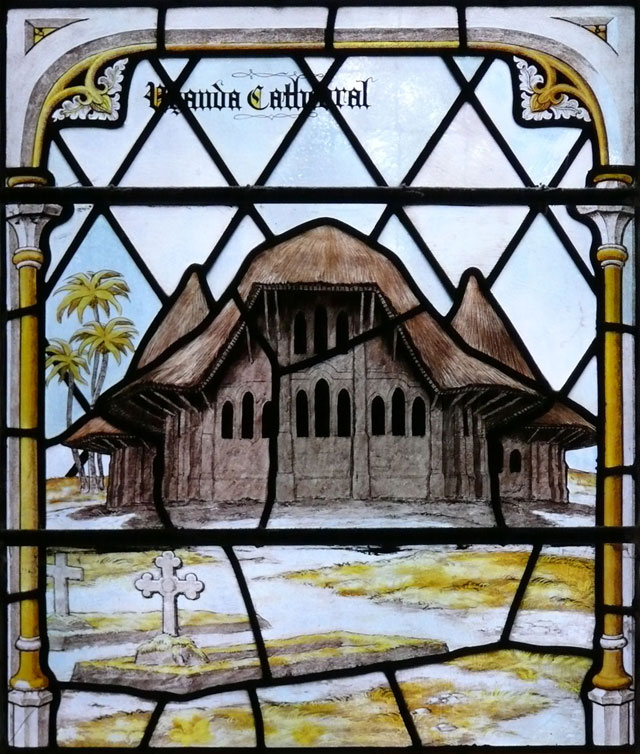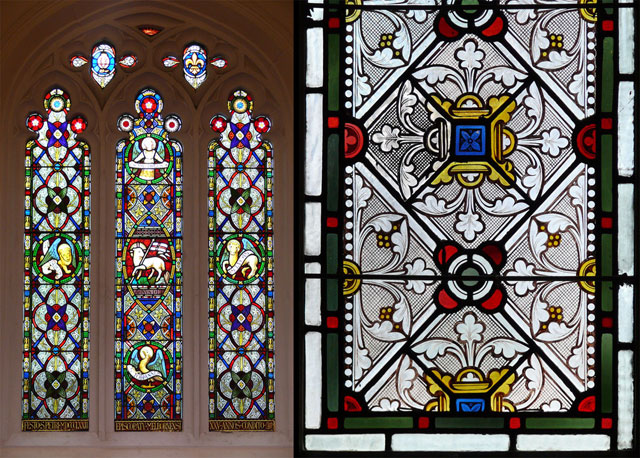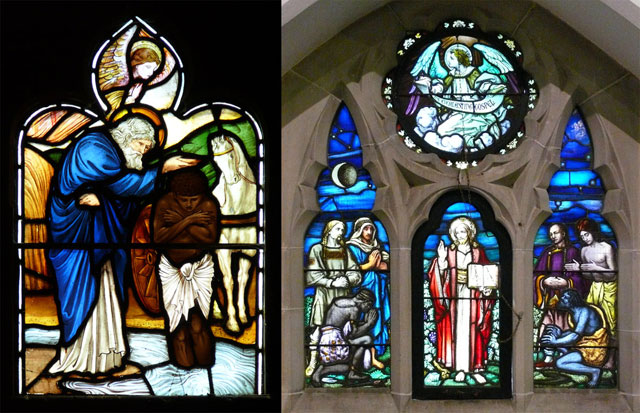In the course of my research on colonial church architecture I had the good fortune to gaze upon many stained glass windows from across the former British colonial world.1 Although I did not discuss these in my book Imperial Gothic, I nonetheless took note of many of them, photographing quite a few along the way.2 Indeed, it occurred to me at the time that the subject of colonial stained glass would make a worthy topic of research in its own right. To date no full and systematic study exists.3
Here I shall take the opportunity to offer some general (and tentative) observations about the types and nature of themes depicted in glass throughout the British Empire, including how stained glass was used as a medium through which to transmit and reinforce certain cultural values. Whether in religious or secular settings, stained glass was deployed deliberately to highlight ideals or causes at the heart of Victorian society (Allen, pp. 152–83). These were wide-ranging, embracing such notions as civilizational advancement, material improvement, moral and spiritual edification, the pioneering impulse, and/or the appropriation and symbolic reassignment of local environments (such as non-European flora, fauna, and people).
In this photoessay I will suggest some potential lines of enquiry for this subject, employing a number of carefully chosen images for the purposes of providing an impression of the range and type of window that engaged with colonial and imperial subject matter during the ‘long’ Victorian period. Each image (or set of images) will be supported with a critical commentary. The images have been chosen for what they reveal about Victorian attitudes towards ideas of sacrifice, heroism, duty, identity, and history as recurring tropes employed in stained glass for visual and didactic effect. The photoessay will also touch upon the processes behind the procurement and transportation of stained glass across the world, considering which manufacturers were involved and in what capacity. In the context of global and imperial commercialization, it will highlight how the material and medium of painted glass can be seen as a category through which cultural, industrial, and commercial networks across the British world were established and maintained.
Commercial ties: a world of stained glass
Church extension and its cultures of building were of course central to the presence of stained glass in the British colonial world (and beyond). Needless to say, churches were a major building typology of the nineteenth-century colonial world, and much recent scholarship has revealed the extent and seriousness of church building throughout the British Empire during this period, including developments in the decorative arts.4 The vast majority of these churches contained stained glass, in some cases large amounts of it, and often of a high quality. Much of this glass, especially before local industries emerged, came from Britain.5 This suggests that there was a fairly significant global export industry in stained glass from Britain during the nineteenth century.
In their study Empire and Globalisation: Networks of People, Goods and Capital in the British World, c. 1850–1914, Gary Magee and Andrew Thompson included a discussion of British-manufactured encaustic tiles as an example of imperially networked consumer habits during this period. In this instance they focused on the famous manufacturers Mintons and Maw & Co. The preferential consumption of such a product was evidence, in their eyes, of a ‘transnational Anglo culture’ at work, and a phenomenon that demonstrated the significant and otherwise inexplicable overlap between empire and the globalization of markets and services.6
Their observation is not backed up with much evidence, but in my experience they are basically correct. In the countless churches that I have visited throughout Britain’s former colonial empire, Minton tiles, or those by rival manufacturers such as Maw & Co., are in evidence virtually everywhere. Wherever one finds British-manufactured encaustic tiles, one usually also finds stained glass. Indeed, as Valda Rigg, among others, has shown, this phenomenon was part of a wider demand in the colonies for medieval-style art and artefacts from Britain during the late nineteenth century, including such devotional objects as illuminated manuscripts.7 With this in mind, stained glass, produced by one or other of the major manufacturers, such as Clayton & Bell, Hardman & Co., or Ballantine & Allan, can also be cited as an index to the consumer culture identified by Magee and Thompson. In my travels I came across glass, in large quantities, not only by the manufacturers mentioned above, but also by Lavers & Barraud, C. E. Kempe, Beer of Exeter, Morris & Co., James Powell & Sons (Whitefriars), William Wailes, Burlison & Grylls, and Percy, Bacon & Bros, to name but a few. Indeed, next to that of Truro Cathedral, St Paul’s Cathedral in Melbourne was Clayton & Bell’s largest single commission.8
Why did so much British-made stained glass find its way to the colonies? And why might this otherwise be unexplainable in a globalized marketplace? The answers are many and varied, but obviously it had a lot to do with the popularity of the Gothic Revival movement in architecture, particularly ecclesiastical architecture, and especially as a pan-imperial phenomenon.9 Accompanying this were certain expectations concerning artistic vision and outcomes. This was of course related to certain demands pertaining to ecclesiastical settings, especially in Roman Catholic and Anglican churches, where degrees of liturgical enhancement were desirable, if not mandatory. This gave scope for the introduction of so-called ‘externals’ in the form of sacramental ornamentation, including stained glass.10 In this respect there was a ready market for stained glass in the colonies. But why so much British glass, especially when there were other manufacturers who were competitive in the global marketplace, such as Mayer & Co. of Munich? Again, Britain had a particularly developed industry by the mid-nineteenth century, but as Magee and Thompson observe, other factors were at play. Here they point to the dynamics of emigration:
It was emigration that conditioned consumption habits within the colonies such that their tastes, expectations and values were readily familiar, communicable and comprehensible to manufacturers back in Britain; and it was emigration that enabled a rapid establishment of trust between commercial partners in the colonies and Britain, thereby facilitating long-distance trade. (p. 118)
As far as Anglican ecclesiology was concerned, these ‘trust networks’ were quite close-knit and thus instrumental, leading to a fairly consistent approach towards the design and decoration of churches, both in Britain and its colonies, including the procurement of stained glass. The production and circulation of pattern books by British manufacturers in the colonies also assisted in maintaining links of commercial loyalty, helping realize that ‘Greater Britain’ conjured by the likes of Charles Dilke, J. R. Seeley, and James Froude.
Inventing history: stained glass and narrative framing
In considering the culture and traditions of British stained glass in a global context, especially in relation to themes such as empire and/or church extension abroad, there are a number of avenues one might fruitfully explore. These include both the secular and religious dimensions of British cultural life. As mentioned, churches are one obvious place to look, but secular buildings of various kinds such as exhibition spaces, museums, galleries, town halls, schools, banks, and even domestic dwellings are others to which one might turn for clues on the subject. Windows in such settings tend to be quite literal or direct in the kinds of themes they depict, with bold imagery, usually concerning some colonial foundation narrative or seminal figure (or figures) in the history of the place concerned, whether it be a town, city, or colony (Figs. 1, 2). Even in churches it is possible to find windows relaying this kind of foundation myth (Fig. 3).
(left): Detail, west wall window, ‘Cathedral Room’, ES&A (now ANZ) Bank, Collins Street, Melbourne, c. 1887, by Ferguson & Urie (possibly Lyon, Cottier & Wells). Photographed by G. A. Bremner. I wish to thank Sue-Anne Williams of Lovell Chen, Melbourne for this information. This roundel depicts two industries that were seen as residing at the foundation of the wealth and success of the colony of Victoria: gold mining, here represented by a prospector (holding a shovel) seated by a river accompanied by his miner’s cradle (used for sifting river gravel); and wool production (represented by sheep), which had become a major export industry not only for Victoria but for much of colonial Australia by the late nineteenth century. Windows of this type, which were not unusual in major banking premises in Australia, aimed at capturing in visual shorthand the idea of industriousness and the pioneering spirit that lay at the heart of nascent Australian nationalist identity; (right): Detail, main stair window, ground floor, Rupertswood, c. 1876, by Ferguson & Urie. Photographed by G. A. Bremner. The set of stained glass windows that grace the main stair hall at Rupertswood mansion in Sunbury, Victoria contain a number of roundels depicting native Australian fauna, including different Australian bird species. Set alongside scenes of hunting, these roundels give the windows a picturesque local dimension. This roundel depicts a platypus, a uniquely Australian creature, and widely regarded at the time as one of the strangest animals in the animal kingdom. Stained glass vignettes of Australian flora and fauna became popular in Australian domestic settings during the latter nineteenth century.
Captain Cook Window, main staircase, Town Hall, Sydney, 1889, by the French designer Lucien Henry for local, Sydney-based manufacturers Goodlet & Smith. Photographed by G. A. Bremner. This window is paired with another depicting an allegory of New South Wales, showing a female figure standing on a globe inscribed ‘Oceania’ and draped in Union Flag-inspired robes. She also sports ram horns emerging from either side of her head, indicating the importance of the wool industry to the economy of New South Wales. Both windows together communicate a colonial foundation narrative of ‘discovery’, industry, and prosperity in the new world — ‘Australia Felix’.
Memorial window to George Wood (d.1884), Grahamstown Cathedral (St Michael and St George), South Africa, c. 1885, artist unknown. Photographed by G. A. Bremner. This window, in a religious setting, depicts the coming and establishment of the ‘1820s settlers’ in the Eastern Cape. It commemorates one George Wood, member of the Legislative Council. As with the Cook window in Sydney, this window highlights and reinforces the foundation narrative of white settlement in the Eastern Cape in the early nineteenth century.
The Victorians’ penchant for visual narrative in the form of history painting and illustration allowed buildings of state such as town halls to employ mural decoration or stained glass (or both) as a means of translating the past into spectacle, with the aim of instilling collective notions of civility and citizenship.11 This was a tactic understood in another contemporary context as related to the instructive and inspirational capacities of art.12 Indeed, the Art-Union journal described methods of this kind as an effective means by which to secure the ‘welfare of the social state by the exhibition of great actions’.13 A certain political economy was evidently associated with such imagery, and this was exploited in places where that ‘welfare’ was in need of deliberate cultivation (Fig. 4).
The Gordon Window, entrance hall to Booloominbah, Armidale, New South Wales, 1901, by Nathaniel Herbert John Westlake for Lavers, Barraud & Westlake. Photographer unknown. The subject for the window was chosen by the house’s owner, Frederick White. Gordon of ‘Khartoum’ — Major General Charles George Gordon (1833–1885) — was a well-known ‘hero’ of empire. White’s choice of a window commemorating Major Gordon’s military campaigns abroad reflects the outburst of British loyalty and imperial pride that followed Gordon’s death during the siege of Khartoum in 1885. There was also a local connection in that a contingent of New South Wales troops was sent to assist the British in the Sudan, and perhaps to avenge Gordon’s death. This act of colonial solidarity was seen by one Englishman visiting Australia at the time as a ‘demonstration in favour of national identity’ See The Gordon Window <https://www.une.edu.au/research/une-research-priorities/humanities-and-creative-arts-research/research-networks-and-groups/19th-century-studies-network/the-gordon-window> [accessed 13 April 2020].
To be sure, stained glass, especially in religious settings, had always been seen to carry this instructive capacity. In the Victorian age, however, this idea was given renewed impetus and meaning. Part of the purpose of the narrative impulse was not just to record and relay local events or scenery as history, but to ‘invent’ history as well. One curious example of this is the stunning portrait windows of the Petit family which grace the J. N. Petit Institute in Mumbai (rebuilt in 1898) (Holliday, pp. 169–76). The Petit family were textile magnates during the boom days of British Bombay and, like most leading Parsi families at the time, were keen philanthropists. These windows thus record and communicate with impressive clarity the ‘joint enterprise’, as Preeti Chopra has called it, of the communal benefits that flowed from commercial and political collaboration with the British in the growth and transformation of that city.14
Another noteworthy example of the Victorian narrative impulse in glass can be found in the programme for windows in the Great Hall at the University of Sydney (Fig. 5). Manufactured by Clayton & Bell, these magnificent windows were designed to invite observers to imagine the University of Sydney as some kind of global extension of the universities of Oxford and Cambridge.15 As the Ecclesiologist noted in 1857, if the buildings themselves in all their Gothic Revival glory were not enough to evoke such a connection, then the hall was to ‘be filled with stained glass; each light containing a figure. The subjects are to be the English Sovereigns, the founders of all the Colleges in Cambridge and Oxford, and the most conspicuous names in English literature.’16 This is ironic given that many of Sydney’s early professors were Scottish, and the educational system itself was based in part on that of the ancient universities of Scotland, not England.17
(left): Detail of panels from the Royal Window, Great Hall, University of Sydney, c. 1859, by Clayton & Bell. Photographed by G. A. Bremner. This window depicts the lineage of the ‘kings and queens of Britain’, dating back to William the Conqueror. Such displays of regal history worked to reinforce connections of culture and government between Britain and its colonial empire, playing into the idea of ‘Greater Britain’ and the commonly held notion that Britain’s settler colonies were so many ‘little England’s beyond the seas’; (right): Detail of panels from the Oxford Window, Great Hall, University of Sydney, c. 1859, by Clayton & Bell. Photographed by G. A. Bremner. The window as a whole indexes the founders of the colleges of the University of Oxford up to the beginning of the seventeenth century. Like the Royal Window, this one, and the ‘Cambridge Window’ at the opposite end of the hall, attempts to establish the University of Sydney as a natural colonial extension of the ancient English university tradition. This detail shows Queen Elizabeth I as founder of Jesus College (1571).
Nevertheless, these windows, as well as the architecture, represent a kind of ritual process of validation that was seen to both legitimate and nationalize educational aspiration and attainment, twelve thousand miles from its centre of inspiration, positing the University of Sydney as a missionary agent of British cultural values.18 The role of such imagery may also be understood as imparting considerable emotional and wider patriotic sentiment, especially in a land that was seen as largely lacking sites of historical and cultural imagining in a European sense. With this in mind, stained glass in such contexts was used both to represent and contrive history in temporal, cultural, and, eventually, racial ways.
Importantly, stained glass of this kind, and the narrative programmes it sought to establish, were often part of wider decorative and symbolic regimes that stood alongside other pictorial schema, such as murals (as mentioned above) or figurative sculpture, both inside buildings and in their immediate vicinity. An example of such a programme can be found at Belfast City Hall (Fig. 6). Here, stained glass windows pointing to regal and unionist themes were installed alongside statuary of British royalty and landed aristocracy, evidenced in the conspicuous statues of Queen Victoria and the Marquess of Dufferin and Ava (both Governor General of Canada and Viceroy of India) which grace the hall’s grounds. In the context of Home Rule politics at the time, a programme of this kind worked to create a distinct atmosphere of empire, leading to an imperial landscape of sorts that spilled from the building’s interior out into the confines of the city beyond (Fig. 7).
Design of window for the Imperial Institute, South Kensington, London, 1892, by Clement Heaton. From the Builder, 29 October 1892. The original decorative scheme for the Imperial Institute in South Kensington is another example of such a programmatic regime in the Victorian era. This design for a window in the building represents the colonies of South Africa and was displayed at the Royal Academy Exhibition of 1892. It sat alongside other similar windows celebrating Britain’s major colonies of settlement, such as Canada and Australasia. The Imperial Institute, as the name suggests, was itself a supreme organ of empire, designed to promote the idea of better and further cooperation between Britain and its colonies. The building was even constructed of materials from across the British colonial world and was to be encrusted with decorative relief sculpture depicting the peoples and resources of the British Empire.
What these examples suggest is that there was a dimension to the use of stained glass in the Victorian and Edwardian periods that concerned both the activation and agitation of patriotic and/or loyalist sentiments (civic and national). In this sense it was part and parcel of what Benedict Anderson would describe as the mechanics and paraphernalia of ‘imagined communities’.19 Looking at buildings of this kind offers another way to understand the relationship between stained glass, its subject matter, its artistic context, and the wider British world.
However, there is perhaps a distinction to be drawn here between the nature of such thematics as they appear in Britain and how they are depicted in the colonies. Although I have not carried out any systematic research on this, my sense is that such themes when represented in glass in Britain tended to be explicitly imperial, to the extent that they were either celebrating Britain’s extension into the wider world in some way (such as in the case of the Imperial Institute), or were commemorative of some person or event that had definite imperial and/or colonial connotations. The Jubilee memorial window (1887) at Great Malvern Priory by R. W. Winfield & Co. (designed by T. W. Camm) springs to mind, as do windows in churches memorializing missionary martyrs or colonial conflicts, such as those commemorating the Second Anglo-Boer War in Winchester Cathedral and at St Leonard’s church, Middleton. Although memorial windows of this kind can be found in colonial contexts (Fig. 8), the tendency was for slightly more diffuse representations of the extension of European civilization, either through the promotion of Christian themes and imagery, or the depiction of ‘pioneering’ deeds.
Detail of memorial window to Lt Keith Kinnaird Mackellar, north wall, St James’ Anglican church, Sydney, c. 1903, by Percy, Bacon & Bros, London. Photographed by G. A. Bremner. This portrait image of Mackellar depicts him as St George, patron saint of soldiers. As such, it also has clear associations with the idea of England and empire, despite Mackellar’s own proud Scottish ancestry.
Martyrdom: memorializing the missionary cause
In the case of ecclesiastical glass, the thematics are ideologically related but scenographically different. Also, as a form of ecclesiastical decoration, stained glass had a sacramental purpose in church settings besides any commemorative purpose it may have served. In Roman Catholic and High Anglican churches, especially, the liturgical east (or chancel) end of the building was considered sacred, with stained glass often used both to indicate and celebrate ideas of holiness. In terms of subject matter, it is once again pertinent to make a distinction here between Britain and the colonies. When one encounters reference to the colonial church in Britain it is usually in relation to missionary martyrdom, or as memorials to those who served the missionary cause in the wider world. At St Ebbe’s church in Oxford (c. 1891), for instance, there is a window of this type dedicated to Thomas Valpy French, Bishop of Lahore (Fig. 9); or, staying with the Asian theme, the windows depicting the great missionary martyr Henry Martyn at Truro Cathedral in Cornwall. Other interesting examples of the type include the Mackenzie memorial window at Haslingfield church in Cambridgeshire (Fig. 10).20
Detail of memorial window to Thomas Valpy French, chancel wall, St Ebbe’s church, Oxford, 1905, by T. W. Camm. Photographed by G. A. Bremner. I wish to thank Simon Bradley for information relating to Figs. 9, 10, 11, 12. Valpy was former vicar of St Ebbe’s before later becoming Bishop of Lahore (1877) after a long career as a missionary in India. This window depicts Valpy French in his mode as a missionary preaching to local indigenous people, clearly distinguishable by their features and clothing. Although addressing a specific place and time in the career of Valpy French, such imagery was often perceived by a wider audience in Britain as representing Christianity’s mission to the ‘heathen’ as a whole.
Details from the memorial window to Charles Mackenzie, south aisle east window, Haslingfield church, Cambridgeshire, 1869, to designs by Frederick Preedy. Photographed by Simon Bradley. Mackenzie was famed as the first bishop of the Universities’ Mission to Central Africa, who died in the field of disease after only one year. His mission was celebrated in Britain for its efforts at stamping out the East African slave trade. These details of the window show Mackenzie preaching to local indigenes (the principal objective of his mission) and barbarous scenes of the East African slave trade, which Mackenzie and his co-labourers worked to frustrate and abolish, later in cooperation with the British government at Zanzibar. The sources for the depiction of slaves in this context were circulating in newspapers, journals, and travel accounts of the time, such as David Livingstone’s Narrative of an Expedition to the Zambesi and its Tributaries (1865).
It is worth pondering for a moment if, and to what extent, such windows were accurate in their depictions of the people and places they depicted; or, whether this even matters. Extant portraits of Mackenzie show that the Haslingfield window is a good likeness, but what about the individual panels and their subject matter? In many ways the window speaks for itself: it commemorates the mission and sacrifice of Charles Mackenzie, once a familiar figure in the pulpit at Haslingfield, who became the first bishop of the Universities’ Mission to Central Africa, that ill-fated endeavour which sought to establish what was termed at the time an autonomous ‘negro church’ in modern-day Malawi, Mozambique, and Tanzania. Its objectives also included stamping out the East African slave trade.
Certain elements among the scenes depicted in the panels are of course stylized, such as the vegetation or the slaves themselves, who, in their facial features at least, look rather more like darkened Caucasians than indigenous sub-Saharan Africans. But what about the basic accuracy of the scene? Were people who gazed upon this window to know any different? Scenes of this type aimed at being accurate and were often based on well-known images circulating in the printed press at the time (which were themselves usually made from in situ sketches). Mackenzie and the UMCA would have been known to most if not all educated Anglican churchgoers in 1860s’ Britain, not least because he and the mission were associated with David Livingstone’s famous expeditions up the Zambezi River in the mid-1850s.
As a tribute to martyrdom, this window clearly played into the ‘missionary hero’ tradition that was current in Victorian culture, which was itself a subset of the wider tendency in Britain to make a virtue of failure.21 We also detect a certain visual economy at work in the immediacy of the scenes represented. It was designed not only to communicate as effectively as possible the moral and righteous basis of Mackenzie’s actions, but was also calculated to prick the Victorian middle-class conscience through an appeal to selflessness and sacrifice.22 Here, issues of Christian duty and trusteeship of non-European indigenes were at the fore.
A similar type of window can be found at St Aldates church in Oxford. In this case the imagery is more general. In the central panel is a depiction of the Lord risen, standing on a globe signifying the worldwide obligation of Christian mission, flanked by martyrs and teachers typical of the first and nineteenth centuries (Fig. 11). On the far left we have the martyred James Hannington of Church Missionary Society fame, Bishop of Uganda, who, like a number of missionary bishops before him, was killed in the field, in Hannington’s case having been captured and executed in 1885 by the Buganda king, Mwanga II, for violating his territorial sovereignty. On the far right is the famous evangelical missionary Henry Martyn. Here too we find an extraordinary depiction of the CMS missionary cathedral atop Namirembe Hill, on the outskirts of modern-day Kampala (Fig. 12). This singular structure has long since vanished (burned down in 1904), and would be all but forgotten today if not for its depiction here, in vivid and accurate detail.
East window, memorial to the Rev. A. W. M. Christopher, St Aldates church, Oxford, c. 1905, artist unknown to author. Photographed by Simon Bradley. As noted in the description, this window illustrates the Church’s duty to ‘Preach the Gospel to every creature’. The missionary themes are strong and clear: Hannington is shown on the far left and Henry Martyn is on the right holding a book and pen as translator of the Bible into Persian and Hindustani.
Windows of this kind, and the imagery they contained, were designed to emphasize two things in particular: first, the ‘good’ that Britain and British civilization was supposed to be doing in the world in bringing ‘progress’ and ‘improvement’, whether spiritual, material, or both. This had something to do with the perceived duty that Britain saw itself as having in the modern world. It also worked to soften, if not morally assuage, home audiences’ attitude towards the more indiscriminate and brutal thrust that lay behind the reality of British imperial expansion.23 Secondly, the imagery emphasized that such a sense of duty was not only willingly acknowledged but also delicately poised, oftentimes requiring considerable sacrifice. In other words, people (in some cases, many people) were willing to die for it. Such windows were therefore an effective device in reminding those who looked upon them of the gravitas of that responsibility and the sacrifices it required. In case those sitting comfortably at home had forgotten what made Britain ‘Great’, such imagery would serve as a type of aide-memoire to what was actually involved in facilitating and maintaining the spiritual and civilizational basis of British political power across the globe.
Such windows and their scenery were of course hardly the preserve of the Anglican Church, and could be found in churches of all denominations across the British world. In the colonies the types of theme one comes across varies, and in parish churches in towns and cities (especially in settler colonies) they include anything one might normally find in a Victorian parish church in Britain. Missionary memorial windows are also found on occasion in such places. In the town of Milawa in northern Victoria (Australia), for instance, there is a window dedicated to Bishop John Coleridge Patteson, the ‘missionary martyr’ of Melanesia. The reasons for its location here are unclear, but it contains scenes of St Paul preaching to the Athenians, and St Stephen being stoned: both biblical references to Patteson’s endeavours, with the latter alluding to his death at the hands of Solomon Islanders in 1871.
Themes that do occur with relative frequency in stained glass in the colonies are those concerning the great missionary apostles, the idea of evangelism, and the sacrament of baptism (Fig. 13). Such subject matter signified the church as being in a missionary and therefore ‘militant’ state, as was indeed the case in many of Britain’s colonies at the time. Moreover, being themes that were also common in stained glass at home, they may be seen as having extended a sense of continuity between the mother country and its colonies. One particularly beautiful if remote rendition of the sacrament of baptism in stained glass can be found in the Anglican church of St Barnabas, Norfolk Island. This window, along with the others in the church, was designed and produced by Morris & Co. (Fig. 14 left). It is notable for its depiction of the baptized as a non-European of dark complexion, in this case an Ethiopian eunuch being baptized by St Philip (Acts 8.26–40). This clearly connects a portrayal of non-European ‘otherness’ with Pacific Island peoples. In this respect the window is both local and universal: local in the sense that it addresses the missionary context of the Pacific Islands; universal in that it can be taken as a general allusion to the spiritual condition of ‘heathendom’, with the black figure standing in as visual shorthand for the peoples of the non-Christian, non-European world (i.e. those that required their souls to be saved). Broader portrayals of Christian mission in stained glass likewise often resorted to depictions of non-European ‘others’ in an attempt to capture the ethnographic dimensions of the worldwide missionary endeavour (Fig. 14 right). This included, as Hilary Carey has argued, a certain desire to subsume indigenous cultures within the frame of a romantic European medieval heritage (‘The Secret of England’s Greatness’).
(left): Bishop’s window, nave (north wall), Christ Church Anglican church, Geelong, Victoria, 1872, by Ferguson & Urie. Photographed by G. A. Bremner. This window represents the relatively widespread theme in the British colonial world of evangelism; (right): Detail of window from Old St Paul’s Cathedral, Wellington, New Zealand, c. 1874, likely by Lavers & Barraud. Photographed by G. A. Bremner. Early in the history of colonial stained glass, particularly where resources were limited, churches, when they could afford stained glass of any kind, opted for grisaille-style patterning for its medieval associations, which became quite common and can be found throughout the British colonial world.
(left): Philip baptizing the eunuch, St Barnabas’s Anglican church, Norfolk Island, c. 1880, designed by Edward Burne-Jones and made by Morris & Co. Photographed by G. A. Bremner. Since the window is on Norfolk Island, the centre of the Church of England’s Melanesian Mission, there is an obvious context for this image. However, much like the other windows mentioned that depict non-European indigenes, such scenery had broader connotations in representing the idea of Christian conversion in the wider world, especially in non-European, non-Christian lands; (right): Window depicting the universal message of Christ, northern aisle, St John’s Anglican church, Toorak, Melbourne, c. 1920, possibly by Ferguson & Urie. Photographed by G. A. Bremner. Similar to the windows at St Barnabas’s and St Ebbe’s mentioned above, this window is explicit in its depiction of humankind as a diverse collection of racial types, including a locational reference to an Australian aboriginal, who cowers in the bottom right. The lower pane of the central panel to this window pulls forward on accordion-style hinges, while the upper circular panel rotates on its axis — both designed to allow ventilation. Such devices remind us of the different and more extreme climates in which modern Christian churches were built, allowing stained glass windows to serve a purpose other than as memorials or decoration. I wish to thank the Rev. Peter French, incumbent of St John’s, for information on this window.
Memory: the enduring allure of home
Feelings of longing and attachment to ‘home’ were also important factors in maintaining the tradition of stained glass in the wider British world. Discourse surrounding colonial church design was replete with aspirations of recreating the old world in the new, and was of course part of wider medievalizing tendencies in Victorian culture, both at home and in the colonies. This was especially the case with Anglican and Roman Catholic ecclesiology, where a certain appeal to medieval authenticity was de rigueur.24 In some cases attempts were made at copying known specimens of medieval stained glass to be sent abroad. For example, at Fredericton Cathedral in New Brunswick, designs from the windows in the chapel at Merton College Oxford were initially mooted, with copies of those from Selby Abbey, Exeter Cathedral, and St Mary’s, Snettisham eventually being sent. These were produced by manufacturers in England such as William Wailes, Robert Beer, and William Warrington.25
Moreover, stained glass was not only beautiful and uplifting in its own right, but also aided in recreating that all-important ‘dim religious light’ so commonly associated with medieval religious space. We know from written accounts that this is something that colonial clergymen remembered with fondness from their lives in England.26 This applied especially in places such as Africa, South Asia, and Australasia, where the light was far more intense (and intrusive) than in northern Europe. In an 1849 number of the Ecclesiologist, for instance, we find a request from St Paul’s church in Chippendale, Sydney for ‘sheets or fragments of glass’ to make stained glass windows for the new building in order to keep out the harsh north light.27 Again, this was concerned with ideas of ‘ecclesiology’ and the setting for what was considered ‘correct’ and dignified religious worship. In many cases it was anticipated that all the windows in a church would eventually be filled with coloured glass of some kind, whether sacramental, commemorative, or just decorative — hence the call in Sydney for any available fragments that might be fitted into existing windows. The hope would have been that, as the congregation grew and consolidated, donors would step forward to supply funds for new, more artistically sophisticated types of stained glass.
This example suggests that there was clearly an emotive power with respect to the use of stained glass in colonial contexts. It not only evoked memories of home but also reaffirmed ideas of a Christian culture that was understood as having its modern origins in Europe. The stresses and strains of this emotive imaginary could be quite profound, as the stark realities of colonial existence tore away at the romantic soul. Take the following passage from an Anglican clergyman in South Africa, the Rev. William Abiah Newman:
It is with much satisfaction that we are enabled to inform our readers, that the English Churches now building at Rondebosch, George, Graff-Reinet, Colesberg, and elsewhere in this colony, will be in a style calculated to recall the ‘goodly fabrics’ in which we have been accustomed to worship in other lands.
In recalling such ‘goodly fabrics’, Newman turned to the poems of Pope:
The reader must therefore bear with us, if, in giving liberty to our unrestrained remembrances, we try to lead him with us to ‘domes with spiry turrets crown’d, | Where awful arches make a noon-day night, | And the dim windows shed a solemn light.’28
Indeed, all Newman’s writings on architecture were deeply felt, if rather saccharine, recollections of a world left far behind. Nevertheless, such pangs, in what might appear to us now as somewhat overwrought language, bring home just how important filtered religious light was understood to be in recreating forms of religious experience in colonial contexts. This atmosphere of sanctity, as Newman called it, was seen as having enhanced value in the colonial world, as it was difficult and often costly to recapture.
Notes
- I wish to thank Gareth Atkins and Jasmine Allen for their helpful comments and advice on earlier drafts of this photoessay. Thanks also to Simon Bradley for allowing me to use some of his photographs of stained glass windows (Figs. 10, 11). [^]
- G. A. Bremner, Imperial Gothic: Religious Architecture and High Anglican Culture in the British Empire, c. 1840–1870 (New Haven: Yale University Press, 2013). [^]
- For a recent development in this direction, see Jasmine Allen, Windows for the World: Nineteenth-Century Stained Glass and the International Exhibitions, 1851–1900 (Manchester: Manchester University Press, 2018). Other studies that cover individual locations or regions include Jenny Zimmer, Stained Glass in Australia (Melbourne: Oxford University Press, 1984); Jude Holliday, Stories in Glass: The Stained Glass Heritage of Bombay (Mumbai: Eminence Designs, 2012); Beverley Sherry, Australia’s Historic Stained Glass (Sydney: Murray Child, 1991); and Bronwyn Eleanor Hughes, ‘Ayrshire to Australia: The First Scottish Australian Stained Glass’, in Scots under the Southern Cross, ed. by Fred Cahir, Anne Beggs Sunter, and Alison Inglis (Ballarat: BHS Publishing, [2014]), pp. 119–33. [^]
- For instance, on colonial church architecture, see (in addition to my own book), Phoebe B. Stanton, The Gothic Revival & American Church Architecture: An Episode in Taste 1840–1856 (Baltimore: Johns Hopkins University Press, 1968); Ian Lochhead, A Dream of Spires: Benjamin Mountfort and the Gothic Revival (Christchurch: University of Canterbury Press, 1999); Brian Andrews, Australian Gothic: The Gothic Revival in Australian Architecture from the 1840s to the 1950s (Carlton: Miegunyah Press, 2001); Brian Andrews, Creating a Gothic Paradise: Pugin at the Antipodes (Hobart: Tasmanian Museum & Art Gallery, 2002); Peter Coffman, Newfoundland Gothic (Quebec: Multimondes, 2008); Barry Magrill, A Commerce of Taste: Church Architecture in Canada 1867–1914 (Montreal: McGill-Queen’s University Press, 2012); and various essays in Gothic Revival Worldwide: A. W. N. Pugin’s Global Influence, ed. by Timothy Brittain-Catlin, Jan De Maeyer, and Martin Bressani (Leuven: Leuven University Press, 2016). [^]
- For one instance of the emergence of a local stained glass manufacturer, see Hughes. [^]
- Gary B. Magee and Andrew S. Thompson, Empire and Globalisation: Networks of People, Goods and Capital in the British World, c. 1850–1914 (Cambridge: Cambridge University Press, 2010), pp. 117–26, 154–66. [^]
- Valda Rigg, ‘Medievalism and the Colonial Imperative: Illuminating their Links in Colonial New South Wales’, reCollections, 4.2 (2009) <https://recollections.nma.gov.au/issues/vol_4_no_2/papers/medievalism> [accessed 13 April 2020]. This demand extended to the recreation of medieval illumination in certain colonial contexts. For example, see Hilary M. Carey, ‘“The Secret of England’s Greatness”: Medievalism, Ornithology, and Anglican Imperialism in the Aboriginal Gospel Book of Sir George Grey’, Journal of Victorian Culture, 16 (2011), 323–46. [^]
- The Windows of St Paul’s Cathedral, Melbourne (Melbourne: St Paul’s Cathedral, [n.d.]), p. 1. The British colonies were an important market for an increasingly competitive and largely untapped stained glass industry. With few exceptions, there were no local makers to meet demand. [^]
- Zimmer, pp. 61–67. Zimmer notes that most of the major British manufacturers mentioned in Martin Harrison’s Victorian Stained Glass (London: Barrie & Jenkins, 1980) were represented in Australia (p. 61). [^]
- For the liturgical arrangement of space in Anglican settings, see Nigel Yates, Buildings, Faith, and Worship: The Liturgical Arrangement of Anglican Churches 1600–1900 (Oxford: Oxford University Press, 1991). [^]
- See, for example, Roy Strong, And When Did You Last See Your Father?: The Victorian Painter and British History (London: Thames & Hudson, 1978); Julie F. Codell, ‘Ford Madox Brown, Carlyle, Macaulay and Bakhtin: The Pratfalls and Penultimates of History’, Art History, 21 (1998), 324–66. [^]
- See G. Alex Bremner, ‘Nation and Empire in the Government Architecture of Mid-Victorian London: The Foreign and India Office Reconsidered’, Historical Journal, 48 (2005), 703–42 (pp. 717–18). [^]
- ‘Royal Commission of Fine Arts’, Art-Union, June 1842, pp. 138–39 (p. 138). [^]
- Preeti Chopra, A Joint Enterprise: Indian Elites and the Making of British Bombay (Minneapolis: University of Minnesota Press, 2011). [^]
- For a discussion of these windows, see Bertha McKenzie, Stained Glass and Stone: The Gothic Buildings of the University of Sydney, Sydney University Monographs, 5 (Sydney: University of Sydney, 1989), pp. 46–66. [^]
- ‘Notices and Answers to Correspondents’, Ecclesiologist, n.s., 14 (1857), 70–72 (p. 72). [^]
- Malcolm Prentis, ‘The Scots in Sydney’, Sydney Journal, 1.2 (2008), 81–89 <https://doi.org/10.5130/sj.v1i2.778> (pp. 83–84). [^]
- For instance, see Tamson Pietsch, Empire of Scholars: Universities, Networks and the British Academic World, 1850–1939 (Manchester: Manchester University Press, 2013). [^]
- Benedict Anderson, Imagined Communities: Reflections on the Origin and Spread of Nationalism (London: Verso, 1983). [^]
- Such memorials were not always explicit in their imagery, as seen, for instance, in the memorial window to George Augustus Selwyn, Bishop of New Zealand, in the chapel at Selwyn College, Cambridge, or the Patteson memorial window at Lincoln Cathedral. [^]
- This idea is the focus of Stephanie Barczewski’s recent study, Heroic Failure and the British (New Haven: Yale University Press, 2016). [^]
- For instance, see the manipulation of imagery associated with the Universities’ Mission to Central Africa in G. Alex Bremner, ‘The Architecture of the Universities’ Mission to Central Africa: Developing a Vernacular Tradition in the Anglican Mission Field, 1861–1909’, Journal of the Society of Architectural Historians, 68 (2009), 514–39 (pp. 517–18). [^]
- Barczewski, p. 11. See also, Bill Schwarz, Memories of Empire (Oxford: Oxford University Press, 2011–), I: The White Man’s World, 67–68. [^]
- For instance, see Andrews, Creating a Gothic Paradise; and Bremner, Imperial Gothic. [^]
- ‘Colonial Church Architecture’, Ecclesiologist, n.s., 7 (1849–50), 192–94; ‘Colonial Church Architecture’, Ecclesiologist, n.s., 9 (1851), 20–24 (pp. 23–24). See also, Stanton, pp. 131–36. [^]
- For instance, see Patteson’s reference to this in Ian Lochhead, ‘Remembering the Middle Ages: Responses to the Gothic Revival in Colonial New Zealand’, in Crossing Cultures: Conflict, Migration and Convergence: The Proceedings of the 32nd International Congress in the History of Art, ed. by Jaynie Anderson (Carlton: Miegunyah Press, 2009), pp. 536–40 (p. 537). [^]
- ‘New Churches’, Ecclesiologist, n.s., 6 (1848–49), 259–65 (p. 264). [^]
- South African Church Magazine, February 1850, pp. 33, 34. [^]

